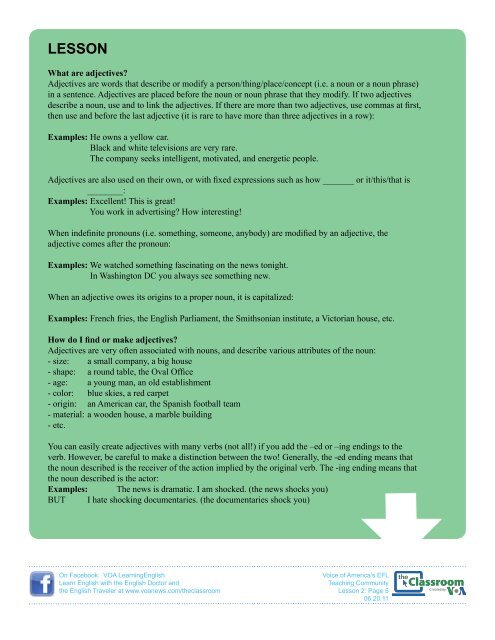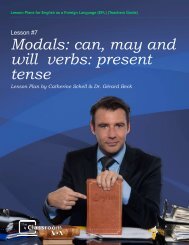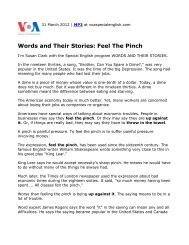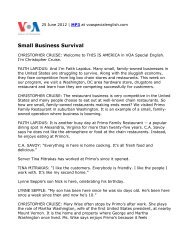Describing People - Voice of America
Describing People - Voice of America
Describing People - Voice of America
You also want an ePaper? Increase the reach of your titles
YUMPU automatically turns print PDFs into web optimized ePapers that Google loves.
LESSON<br />
What are adjectives?<br />
Adjectives are words that describe or modify a person/thing/place/concept (i.e. a noun or a noun phrase)<br />
in a sentence. Adjectives are placed before the noun or noun phrase that they modify. If two adjectives<br />
describe a noun, use and to link the adjectives. If there are more than two adjectives, use commas at first,<br />
then use and before the last adjective (it is rare to have more than three adjectives in a row):<br />
Examples: He owns a yellow car.<br />
Black and white televisions are very rare.<br />
The company seeks intelligent, motivated, and energetic people.<br />
Adjectives are also used on their own, or with fixed expressions such as how _______ or it/this/that is<br />
________:<br />
Examples: Excellent! This is great!<br />
You work in advertising? How interesting!<br />
When indefinite pronouns (i.e. something, someone, anybody) are modified by an adjective, the<br />
adjective comes after the pronoun:<br />
Examples: We watched something fascinating on the news tonight.<br />
In Washington DC you always see something new.<br />
When an adjective owes its origins to a proper noun, it is capitalized:<br />
Examples: French fries, the English Parliament, the Smithsonian institute, a Victorian house, etc.<br />
How do I find or make adjectives?<br />
Adjectives are very <strong>of</strong>ten associated with nouns, and describe various attributes <strong>of</strong> the noun:<br />
- size: a small company, a big house<br />
- shape: a round table, the Oval Office<br />
- age: a young man, an old establishment<br />
- color: blue skies, a red carpet<br />
- origin: an <strong>America</strong>n car, the Spanish football team<br />
- material: a wooden house, a marble building<br />
- etc.<br />
You can easily create adjectives with many verbs (not all!) if you add the –ed or –ing endings to the<br />
verb. However, be careful to make a distinction between the two! Generally, the -ed ending means that<br />
the noun described is the receiver <strong>of</strong> the action implied by the original verb. The -ing ending means that<br />
the noun described is the actor:<br />
Examples: The news is dramatic. I am shocked. (the news shocks you)<br />
BUT I hate shocking documentaries. (the documentaries shock you)<br />
On Facebook: VOA LearningEnglish<br />
Learn English with the English Doctor and<br />
the English Traveler at www.voanews.com/theclassroom<br />
<strong>Voice</strong> <strong>of</strong> <strong>America</strong>’s EFL<br />
Teaching Community<br />
Lesson 2: Page 5<br />
06.20.11






